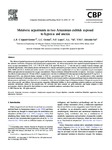Por favor, use este identificador para citar o enlazar este ítem:
http://www.alice.cnptia.embrapa.br/alice/handle/doc/677336Registro completo de metadatos
| Campo DC | Valor | Lengua/Idioma |
|---|---|---|
| dc.contributor.author | CHIPPARI-GOMES, A. R. | pt_BR |
| dc.contributor.author | GOMES, L. C. | pt_BR |
| dc.contributor.author | LOPES, N. P. | pt_BR |
| dc.contributor.author | VAL. A. L. | pt_BR |
| dc.contributor.author | ALMEIDA-VAL, V. M. F. | pt_BR |
| dc.date.accessioned | 2015-01-07T08:23:06Z | - |
| dc.date.available | 2015-01-07T08:23:06Z | - |
| dc.date.created | 2006-02-14 | pt_BR |
| dc.date.issued | 2005 | pt_BR |
| dc.identifier.citation | Comparative Biochemistry and Physiology Part B: Biochemistry and Molecular Biology, v. 141, n. 3, p. 347-355, jul. 2005. | pt_BR |
| dc.identifier.uri | http://www.alice.cnptia.embrapa.br/alice/handle/doc/677336 | pt_BR |
| dc.description | The effects of graded hypoxia on the physiological and biochemical responses were examined in two closely related species of cichlids of the Amazon: Astronotus crassipinnis and Symphysodon aequifasciatus. Ten fish of each species were exposed to graded hypoxia for 8 h in seven oxygen concentrations (5.92, 3.15, 1.54, 0.79, 0.60, 0.34, and 0.06 mg O2 L- 1), with the aim to evaluate hypoxia tolerance and metabolic adjustments, where plasma glucose and lactate levels, hepatic and muscle glycogen contents, and maximum enzyme activities (PK, LDH, MDH and CS) in skeletal and cardiac muscles were measured. Another experimental set was done to quantify oxygen consumption (MO2) and opercular movements in two oxygen concentrations. Hypoxia tolerance differed between the two species. Astronotus crassipinnis was able to tolerate anoxia for 178 min while S. aequifasciatus was able to withstand 222 min exposure in deep hypoxia (0.75 mg O2 L- 1). Suppressed MO2 was observed during exposure to 0.34 (A. crassipinnis) and 0.79 mg O2 L- 1 (S. aequifasciatus), while opercular movements increased in both species exposed to hypoxia. Higher levels of muscle and liver glycogen and larger hypoxia-induced increases in plasma glucose and lactate were observed in A. crassipinnis, which showed a higher degree of hypoxia tolerance. Changes in enzyme levels were tissue-specific and differed between species suggesting differential abilities in down-regulating oxidative pathways and increasing anaerobic metabolism. Based on the present data, we conclude that these animals are good anaerobes and highly adapted to their environment, which is allowed by their abilities to regulate metabolic pathways and adjust their enzyme levels. | pt_BR |
| dc.language.iso | eng | eng |
| dc.rights | openAccess | eng |
| dc.subject | Astronotus crassipinnis | pt_BR |
| dc.subject | Hipoxia | pt_BR |
| dc.subject | Tolerância | pt_BR |
| dc.title | Metabolic adjustments in two Amazonian cichlids exposed to hypoxia and anoxia. | pt_BR |
| dc.type | Artigo de periódico | pt_BR |
| dc.date.updated | 2015-01-07T08:23:06Z | pt_BR |
| dc.subject.thesagro | Peixe | pt_BR |
| dc.subject.nalthesaurus | Amazonia | pt_BR |
| dc.subject.nalthesaurus | Symphysodon aequifasciatus | pt_BR |
| riaa.ainfo.id | 677336 | pt_BR |
| riaa.ainfo.lastupdate | 2015-01-06 | pt_BR |
| dc.contributor.institution | INPA; Embrapa Amazônia Ocidental. | pt_BR |
| Aparece en las colecciones: | Artigo em periódico indexado (CPAA)  | |
Ficheros en este ítem:
| Fichero | Descripción | Tamaño | Formato | |
|---|---|---|---|---|
| 1s2.0S1096495905000850main.pdf | 243,75 kB | Adobe PDF |  Visualizar/Abrir |









